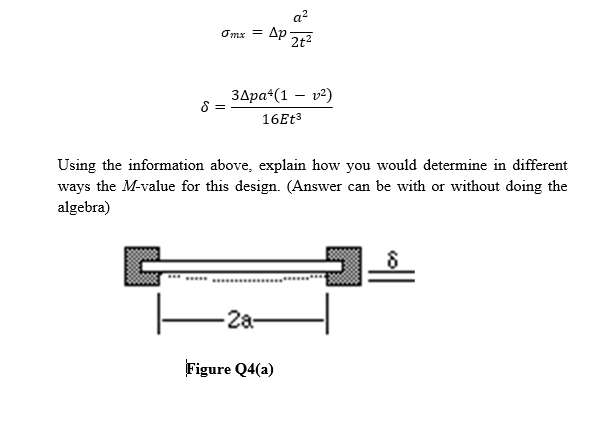Based on Figure Q4(a), the diaphragm in a differential pressure gauge deflects proportionally with the pressure difference across it. This deflection is used to measure the pressure difference, QR. To operate well, the material must not fail under the loading, and it should have a large deflection in order to increase the sensitivity of the measurement. The equations below for maximum stress and of a circular diaphragm of fixed radius are important to answer this question. The diaphragm thickness is t, E is Young's Modulus, and v is Poisson's ratio.
Based on Figure Q4(a), the diaphragm in a differential pressure gauge deflects proportionally with the pressure difference across it. This deflection is used to measure the pressure difference, QR. To operate well, the material must not fail under the loading, and it should have a large deflection in order to increase the sensitivity of the measurement. The equations below for maximum stress and of a circular diaphragm of fixed radius are important to answer this question. The diaphragm thickness is t, E is Young's Modulus, and v is Poisson's ratio.
Elements Of Electromagnetics
7th Edition
ISBN:9780190698614
Author:Sadiku, Matthew N. O.
Publisher:Sadiku, Matthew N. O.
ChapterMA: Math Assessment
Section: Chapter Questions
Problem 1.1MA
Related questions
Question
PLEASE ANSWER QUICKLY WITHIN 30 MINUTES

Transcribed Image Text:Q4 (a) Based on Figure Q4(a), the diaphragm in a differential pressure gauge deflects
proportionally with the pressure difference across it. This deflection is used to
measure the pressure difference, g, To operate well, the material must not fail
under the loading, and it should have a large deflection in order to increase the
sensitivity of the measurement. The equations below for maximum stress and
of a circular diaphragm of fixed radius are important to answer this question.
The diaphragm thickness is t, E is Young's Modulus, and v is Poisson's ratio.

Transcribed Image Text:a?
Omx = AP 3+2
Здра"(1 — v?)
16Et3
Using the information above, explain how you would determine in different
ways the M-value for this design. (Answer can be with or without doing the
algebra)
2a
Figure Q4(a)
Expert Solution
This question has been solved!
Explore an expertly crafted, step-by-step solution for a thorough understanding of key concepts.
Step by step
Solved in 2 steps with 1 images

Knowledge Booster
Learn more about
Need a deep-dive on the concept behind this application? Look no further. Learn more about this topic, mechanical-engineering and related others by exploring similar questions and additional content below.Recommended textbooks for you

Elements Of Electromagnetics
Mechanical Engineering
ISBN:
9780190698614
Author:
Sadiku, Matthew N. O.
Publisher:
Oxford University Press

Mechanics of Materials (10th Edition)
Mechanical Engineering
ISBN:
9780134319650
Author:
Russell C. Hibbeler
Publisher:
PEARSON

Thermodynamics: An Engineering Approach
Mechanical Engineering
ISBN:
9781259822674
Author:
Yunus A. Cengel Dr., Michael A. Boles
Publisher:
McGraw-Hill Education

Elements Of Electromagnetics
Mechanical Engineering
ISBN:
9780190698614
Author:
Sadiku, Matthew N. O.
Publisher:
Oxford University Press

Mechanics of Materials (10th Edition)
Mechanical Engineering
ISBN:
9780134319650
Author:
Russell C. Hibbeler
Publisher:
PEARSON

Thermodynamics: An Engineering Approach
Mechanical Engineering
ISBN:
9781259822674
Author:
Yunus A. Cengel Dr., Michael A. Boles
Publisher:
McGraw-Hill Education

Control Systems Engineering
Mechanical Engineering
ISBN:
9781118170519
Author:
Norman S. Nise
Publisher:
WILEY

Mechanics of Materials (MindTap Course List)
Mechanical Engineering
ISBN:
9781337093347
Author:
Barry J. Goodno, James M. Gere
Publisher:
Cengage Learning

Engineering Mechanics: Statics
Mechanical Engineering
ISBN:
9781118807330
Author:
James L. Meriam, L. G. Kraige, J. N. Bolton
Publisher:
WILEY